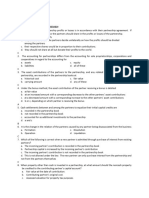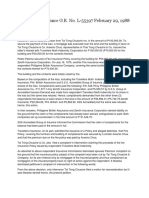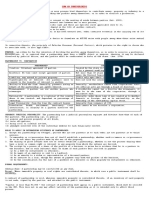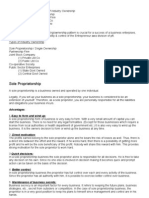AST Chapter 2
AST Chapter 2
Uploaded by
ElleCopyright:
Available Formats
AST Chapter 2
AST Chapter 2
Uploaded by
ElleCopyright
Available Formats
Share this document
Did you find this document useful?
Is this content inappropriate?
Copyright:
Available Formats
AST Chapter 2
AST Chapter 2
Uploaded by
ElleCopyright:
Available Formats
dds
CHAPTER 2 (PARTNERSHIP DISSOLUTION) Case C – C is to purchase ¼ interest from the partnership paying P85,000
• Dissolution – change in relation of the partners of the partners caused by A, Capital 62,500
any partner ceasing to be associated in the carrying on of the business B, Capital 18,750
C, Capital 81,250
▲ Causes of Dissolution
• Admission of New Partner Amount paid 85,000
■ By purchase of interest Less: Capital contribution (81,250)
■ By investment Gain shared by old partners 3,750
• Removal of Old Partner
■ Withdrawal or retirement - The P3,750 is personal gain for A and B and a personal loss of C
■ Death or incapacity
• Incorporation of a partnership
Cap admission before Equity purchased Cap admission after
P/L Capital P/L Capital P/L Capital
▲ Admission of a New Partner
A 60% 250,000 (¼ ) (62,500) 45% 187,500
• Admission by purchase – a new partner can be admitted with the
B 40% 75,000 (¼ ) (18,750) 30% 56,250
consent of all partners in the business
C ¼ 81,250 25% 81,250
Total 100% 325,000 100% 325,000
ILLUSTRATION 1
A and B are partners with capital balances of P250,000 and P75,000
respectively. They share profits and losses 60% and 40% respectively. C Case D – C is to purchase 1/2 interest of A and B by paying P165,000
will be admitted as a new partner A, Capital 125,000
B, Capital 37,500
Case A – C is to purchase ¼ interest from A paying P70,500 C, Capital 162,500
A, Capital 62,500
C, Capital 62,500
Cap admission before Equity purchased Cap admission after
P/L Capital P/L Capital P/L Capital
- The 8,000 is a personal gain for C and a personal loss for A
A 60% 250,000 (½ ) (125,000) 30% 125,000
- The old partnership is dissolved and the new partners should agree on
B 40% 75,000 (½ ) (37,500) 20% 37,500
new profit and loss
C ½ 162,500 50% 162,500
- In the absence of agreement, it is presumed that the residual P/L after
giving the new partner his interest purchased will be assigned to the selling Total 100% 325,000 100% 325,000
partner
• Admission by Investment – admission where an individual may obtain
Cap admission before Equity purchased Cap admission after interest on capital and earnings of the partnership by investing cash or non-
P/L Capital P/L Capital P/L Capital cash assets into partnership
A 60% 250,000 (¼ ) (62,500) 45% 187,500
- The investment of the incoming partner will be recorded in the books
partnership, thus, the net assets of the partnership will increase after the
B 40% 75,000 40% 75,000
admission
C ¼ 62,500 15% 62,500
Total 100% 325,000 100% 325,000 ■ Bonus approach – under this method, the total contributed capital will
be equal to total agreed capital
Case B – C is to purchase ¼ interest from B paying P20,000 - AC of new partner > Contributed capital of new partner = Bonus to new
partner
A, Capital 18,750
- AC of new partner < Contributed capital of new partner = Bonus to old
C, Capital 18,750
partner
- The P1,250 is a personal gain for A and a personal loss for C
ILLUSTRATION 2
Harry and Potter are partners with capital balances of 120,000 and 80,000,
Cap admission before Equity purchased Cap admission after respectively. Their profit and loss ratio is 3:2. Hogwarts will be admitted
P/L Capital P/L Capital P/L Capital as a new partner
A 60% 250,000 60% 250,000
B 40% 75,000 (¼ ) (18,750) 30% 56,250 Case A – Capital credit is equal to the amount invested
C ¼ 18,750 10% 18,750 Hogwarts will invest 40,000 for 1/6 interest in the partnership capital and
40% share in profit and loss
Total 100% 325,000 100% 325,000
Cash 40,000
Hogwarts, Capital 40,000
- The share of Hogwarts in total AC is (240,000*1/6) P40,000 which is
equal to his cash investment, therefore, no bonus is recognized.
Pagatpat, Aischelle Mhae R.
dds
CC AC Bonus Old P/L New P/L
Harry 120,000 120,000 Harry 60% 80% * 60* 48%
Potter 80,000 80,000 Potter 40% 80% * 40% 32%
Hogwarts 40,000 40,000 Hogwarts 20%
Total 240,000 240,000
■ Asset Revaluation Approach – under this method, the contribution of
- Admission of a new partner results to the dissolution of the old the new partner is used as basis in determining the total agreed capital of
partnership, thus creating a new partnership the partnership
- Under the new agreement, the new profit and loss ratio is computed as - Total AC = Total CC = No revaluation
follows: - Total AC > Total CC = Positive revaluation
- Total AC < Total CC = Negative revaluation
Old P/L New P/L
Harry 60% 60% * 60* 36% ILLUSTRATION 3
Gryffindor and Slytherin are partners with capital balances of 125,000 and
Potter 40% 60% * 40% 24%
75,000, respectively. The profit and loss ratio is 3:2. Hufflepuff will be
Hogwarts 40% admitted as a new partner
Case B – Capital credit is less than the amount invested (Bonus to old Case A – Total AC = Total CC = No revaluation
partner) Hufflepuff will invest 40,000 for 1/6 interest in the partnership capital and
Hogwarts will invest 40,000 1/8 interest in the partnership capital and 20% share in profit and loss.
profit and loss Cash 40,000
Cash 40,000 Hufflepuff, Capital 40,000
Hogwarts, Capital (240K*1/8) 30,000
Harry, Capital (10K*3/5) 6,000 CC AC Revaluation
Potter, Capital (10K*2/5) 4,000 Gryffindor 125,000 125,000
Slytherin 75,000 75,000
CC AC Bonus
Hufflepuff 40,000 40,000
Harry 120,000 126,000 6,000
Total 240,000 240,000
Potter 80,000 84,000 4,000
Hogwarts 40,000 30,000 (10,000)
Old P/L New P/L
Total 240,000 240,000
Gryffindor 60% 80% * 60* 48%
Slytherin 40% 80% * 40% 32%
Old P/L New P/L
Hufflepuff 20%
Harry 60% 87.5% * 60* 52.5%
Potter 40% 87.5% * 40% 35%
Case B – Total AC > Total CC = Positive revaluation
Hogwarts 12.5% Hufflepuff will invest 60,000 for 20% interest in the partnership capital
and 25% share in profit and loss.
Case C – Capital credit is greater than the amount invested (Bonus to new Other assets 40,000
partner) Gryffindor, Capital 24,000
Hogwarts will invest 40,000 1/5 interest in the partnership capital and Slytherin, Capital 16,000
profit and loss
Cash 40,000 Cash 60,000
Harry, Capital (8K*3/5) 4,800 Hufflepuff, Capital 60,000
Potter, Capital (8K*2/5) 3,200
Hogwarts, Capital (240K*1/5) 48,000
CC AC Revaluation
Gryffindor 125,000 149,000 24,000
CC AC Bonus
Slytherin 75,000 91,000 16,000
Harry 120,000 115,200 (4,800)
Hufflepuff 60,000 60,000
Potter 80,000 76,800 (3,200)
Total 260,000 300,000 40,000
Hogwarts 40,000 48,000 8,000
Total 240,000 240,000
Pagatpat, Aischelle Mhae R.
dds
Old P/L New P/L ■ Sale of interest to the partnership
Baba decided to retire from the partnership to pursue his singing career
Gryffindor 60% 75% * 60* 45%
Slytherin 40% 75% * 40% 30%
Case 1 – The partnership paid 500,000 to Baba
Hufflepuff 25% Baba, Capital 500,000
Cash 500,000
Case C – Total AC < Total CC = Negative revaluation
Hufflepuff will invest 60,000 for 25% interest in the partnership capital - Since the amount paid by the partnership to Baba is equal to his interests,
and 30% share in profit and loss. neither bonus revaluation of assets will be recognized
Gryffindor, Capital 12,000
Slytherin, Capital 8,000 Case 2 – The partnership paid 620,000 to Baba
Other assets 20,000 ◊ Bonus approach
Bonus=Excess∗P /L without retiring partner
Cash 60,000
Hufflepuff, Capital 60,000 Bebe bonus
120,000 * 4/6 = 80,000
CC AC Revaluation
Gryffindor 125,000 149,000 (12,000) Bubu bonus
Slytherin 75,000 91,000 (8,000) 120,000 * 2/6 = 40,000
Hufflepuff 60,000 60,000
Baba, Capital 500,000
Total 260,000 240,000 (20,000)
Bebe, Capital 80,000
Bubu, Capital 40,000
Old P/L New P/L Cash 620,000
Gryffindor 60% 70% * 60* 42%
Slytherin 40% 70% * 40% 28% ◊ Revaluation approach
Hufflepuff 30% Revaluation=Excess / P/ L retiring partner
▲ Withdrawal, Retirement or Death of a Partner Share∈ℜ valuation=Revaluation∗P /L
- If a partner withdraws or retire from the partnership, the interest of
withdrawing/retiring partner must be liquidated - Settlement > Capital = Positive Revaluation
- Settlement < Capital = Negative Revaluation
• Ways On Liquidating The Interest
ILLUSTRATION 4 Positive Revaluation
Baba, Bebe and Bubu are partners of Bekenemen Partnership engage in the Excess 120,000
distribution of maple syrup in the town of Sweetwater River. Their capital Divide: P/L Baba 40%
balances and profit and loss ratio are Baba 40%-500,000; Bebe 40%-
300,000; Bubu 20%-200,000. Revaluation 300,000
■ Sale of interest to outsider Other assets 300,000
Baba decided to retire from the partnership and with the consent of Bebe Baba, Capital 120,000
and Bubu, he sold his interest to Kaka for 600,000 Bebe, Capital 120,000
Baba, Capital 500,000 Bubu, Capital 60,000
Kakaa, Capital 500,000
Case 3 – The partnership paid 450,000 to Baba
■ Sale of interest to one or more continuing partners ◊ Bonus approach
Baba decided to retire from the partnership and sold his interest to Bubu Bebe bonus
for 400,000 50,000 * 4/6 = 33,333
Baba, Capital 500,000
Bubu, Capital 500,000 Bubu bonus
50,000 * 2/6 = 16,667
Baba, Capital 500,000
Bebe, Capital 33,333
Bubu, Capital 16,667
Pagatpat, Aischelle Mhae R.
dds
◊ Revaluation approach
Negative revaluation
Excess 50,000
Divide: P/L Baba 40%
Revaluation 125,000
Baba, Capital 50,000
Bebe, Capital 50,000
Bubu, Capital 25,000
Other assets 125,000
Baba, Capital 450,000
Cash 450,000
Pagatpat, Aischelle Mhae R.
You might also like
- CHAPTER 13 - Partnership Dissolution (PROBLEM 4-Multiple Choice)Document5 pagesCHAPTER 13 - Partnership Dissolution (PROBLEM 4-Multiple Choice)Penelope Palcon0% (1)
- Chapter 13 - Partnership Dissolution (Problem 3-Journal Entries)Document11 pagesChapter 13 - Partnership Dissolution (Problem 3-Journal Entries)Penelope Palcon80% (5)
- Chapter 4 Partnership Dissolution Without Liquidation ANSWERS To EXERCISE 4-1 To 4-11 PDFDocument19 pagesChapter 4 Partnership Dissolution Without Liquidation ANSWERS To EXERCISE 4-1 To 4-11 PDFJose GuerreroNo ratings yet
- Partnership DissolutionDocument11 pagesPartnership DissolutionJannah AlcaideNo ratings yet
- AC - IntAcctg-A LSLiquidation.Document41 pagesAC - IntAcctg-A LSLiquidation.Janesene SolNo ratings yet
- Group 3Document98 pagesGroup 3Tintin CastañedaNo ratings yet
- AST Discussion 3 - PARTNERSHIP DISSOLUTIONDocument5 pagesAST Discussion 3 - PARTNERSHIP DISSOLUTIONCHRISTINE TABULOGNo ratings yet
- Interim Assessment 1 With Answer KeysDocument6 pagesInterim Assessment 1 With Answer KeyscaraaatbongNo ratings yet
- Suggested - Answer - CAP - II - June - 2016 6Document75 pagesSuggested - Answer - CAP - II - June - 2016 6Dipen AdhikariNo ratings yet
- AFAR Self Test - 9001Document5 pagesAFAR Self Test - 9001King MercadoNo ratings yet
- Partnership DissolutionDocument46 pagesPartnership Dissolutionxenovia chuchuNo ratings yet
- ILLUSTRATIVE PROBLEMS - Partnership Dissolution (Change in Ownership Structure)Document5 pagesILLUSTRATIVE PROBLEMS - Partnership Dissolution (Change in Ownership Structure)Mathew LumapasNo ratings yet
- Lecture 7 Company AccountingDocument25 pagesLecture 7 Company AccountingSalah MobarakNo ratings yet
- Partnership Q1 To Q3 SolutionsDocument8 pagesPartnership Q1 To Q3 SolutionsJAYARAJALAKSHMI IlangoNo ratings yet
- Prelim Exam Part 2 SolutionsDocument4 pagesPrelim Exam Part 2 SolutionseaeNo ratings yet
- Partnership Dissolution 4Document6 pagesPartnership Dissolution 4Karl Wilson GonzalesNo ratings yet
- LQ 2 AnswersDocument21 pagesLQ 2 Answersby ScribdNo ratings yet
- 94 - CPAR Final Preaboard AFAR - BookletDocument14 pages94 - CPAR Final Preaboard AFAR - Booklettheresabalagata03No ratings yet
- Prelimexamacct1103withanswerandsolutiondocx PDF FreeDocument14 pagesPrelimexamacct1103withanswerandsolutiondocx PDF FreeBaby OREO0% (1)
- Group 2 (Bsacc 1-2)Document4 pagesGroup 2 (Bsacc 1-2)Kristine Nicole T. SalvadorNo ratings yet
- Cpar - Afar - Reviewer - QuizbeeDocument27 pagesCpar - Afar - Reviewer - QuizbeeYvonne MalingNo ratings yet
- Larong Aihzel G. Ast Long Quiz 1Document5 pagesLarong Aihzel G. Ast Long Quiz 1Mitch Tokong MinglanaNo ratings yet
- Afar 1 Module - Topic 3Document12 pagesAfar 1 Module - Topic 3mallarijhoana21No ratings yet
- Long QuizDocument5 pagesLong QuizMitch Tokong MinglanaNo ratings yet
- Accounting For Partnership DissolutionDocument51 pagesAccounting For Partnership DissolutionRica Ella RestauroNo ratings yet
- Partnership Dis.03.14.2024Document72 pagesPartnership Dis.03.14.2024axeaapolloNo ratings yet
- AFAR-01C Partnership DissolutionDocument7 pagesAFAR-01C Partnership DissolutionLouie RobitshekNo ratings yet
- AST 4-Partnership DissolutionDocument9 pagesAST 4-Partnership DissolutionMarvin MercadoNo ratings yet
- Lesson 2. Partnership FormationDocument6 pagesLesson 2. Partnership Formationangelinelucastoquero548No ratings yet
- 4A8 FormationDocument5 pages4A8 FormationCarl Dhaniel Garcia SalenNo ratings yet
- Hsslive Xii Accountancy AFS KEY Dec 2024Document8 pagesHsslive Xii Accountancy AFS KEY Dec 2024sakkeenasakki62No ratings yet
- Partnership Lecture 5Document6 pagesPartnership Lecture 5ramimohd97No ratings yet
- DIY LiquidationDocument27 pagesDIY LiquidationJOYCE C ANDADORNo ratings yet
- Solutions and ExplanationsDocument30 pagesSolutions and Explanationsandrea.huerto0730No ratings yet
- PARTNERSHIP DISSOLUTION Part 2Document9 pagesPARTNERSHIP DISSOLUTION Part 2je jeNo ratings yet
- Assign 3 Answer Partnership Dissolution Millan 2021Document6 pagesAssign 3 Answer Partnership Dissolution Millan 2021mhikeedelantarNo ratings yet
- Assign 3 Answer Partnership Dissolution Millan 2021Document6 pagesAssign 3 Answer Partnership Dissolution Millan 2021mhikeedelantarNo ratings yet
- Assign 3 Answer Partnership Dissolution Millan 2021Document6 pagesAssign 3 Answer Partnership Dissolution Millan 2021mhikeedelantarNo ratings yet
- Prob 14Document3 pagesProb 14Abegail DuhanNo ratings yet
- Afar 02 Partnership Dissolution LiquidationDocument16 pagesAfar 02 Partnership Dissolution LiquidationMikael James VillanuevaNo ratings yet
- Full Acc Test 8 AnswersDocument12 pagesFull Acc Test 8 Answersnavyabohra3105No ratings yet
- DissolutionDocument4 pagesDissolutionQueenie MaglalangNo ratings yet
- Homework ch4 11-4-2020Document5 pagesHomework ch4 11-4-2020Qasim MansiNo ratings yet
- AFAR-02 (Partnership Dissolution & Liquidation)Document15 pagesAFAR-02 (Partnership Dissolution & Liquidation)Jennelyn CapenditNo ratings yet
- AFAR-02 (Partnership Dissolution & Liquidation)Document15 pagesAFAR-02 (Partnership Dissolution & Liquidation)Shiela NacasiNo ratings yet
- CACell_Intermediate_Account_Full_Book-101-150Document50 pagesCACell_Intermediate_Account_Full_Book-101-150abhinesh neshNo ratings yet
- Implied Value Implied Value BV Equity BV EquityDocument12 pagesImplied Value Implied Value BV Equity BV Equitysean franciscusNo ratings yet
- AFAR-02 (Partnership Dissolution & Liquidation)Document13 pagesAFAR-02 (Partnership Dissolution & Liquidation)Maricris AlilinNo ratings yet
- Assignment 2 Special TransDocument38 pagesAssignment 2 Special TransFaithful FighterNo ratings yet
- Guarantee of Profits: Profit & Loss Appropriation A/cDocument4 pagesGuarantee of Profits: Profit & Loss Appropriation A/cVarun RaghunathanNo ratings yet
- 1. Lecture Admission by PurchaseDocument5 pages1. Lecture Admission by PurchaseJethro TeriaNo ratings yet
- 12 Acc Accoun Partner Firm Fundamentals Im6 PDFDocument12 pages12 Acc Accoun Partner Firm Fundamentals Im6 PDFDID You KNOWNo ratings yet
- WEEK 6-7 ULO A, B, C Answer KeyDocument4 pagesWEEK 6-7 ULO A, B, C Answer Keyzee abadilla100% (1)
- CH 7 Vol 1 2012 AnswersDocument18 pagesCH 7 Vol 1 2012 Answersprince karlNo ratings yet
- Key Quiz 3 1st 2022 20223Document4 pagesKey Quiz 3 1st 2022 20223Leslie Mae Vargas ZafeNo ratings yet
- AFAR-02 (Partnership Dissolution and Liquidation)Document15 pagesAFAR-02 (Partnership Dissolution and Liquidation)Kristel Denise TansiongcoNo ratings yet
- Partnership Accounting: FormationDocument6 pagesPartnership Accounting: FormationLee SuarezNo ratings yet
- B, Capital After Admission 480,000: Problem 1 #1Document6 pagesB, Capital After Admission 480,000: Problem 1 #1Alizah BucotNo ratings yet
- Partnership Dissolution Name: Date: Professor: Section: Score: QuizDocument5 pagesPartnership Dissolution Name: Date: Professor: Section: Score: QuizNahwi KimpaNo ratings yet
- Wiley Practitioner's Guide to GAAS 2017: Covering all SASs, SSAEs, SSARSs, and InterpretationsFrom EverandWiley Practitioner's Guide to GAAS 2017: Covering all SASs, SSAEs, SSARSs, and InterpretationsNo ratings yet
- Bernie Madoff - Overview, History, and The Ponzi SchemeDocument7 pagesBernie Madoff - Overview, History, and The Ponzi SchemeElleNo ratings yet
- StratCost Quiz 2Document6 pagesStratCost Quiz 2ElleNo ratings yet
- Enron Scandal - Summary, Explained, History, & Facts - BritannicaDocument4 pagesEnron Scandal - Summary, Explained, History, & Facts - BritannicaElleNo ratings yet
- Unit Iii:: Income Tax ON CorporationsDocument35 pagesUnit Iii:: Income Tax ON CorporationsElleNo ratings yet
- Enron Scandal - The Fall of A Wall Street DarlingDocument11 pagesEnron Scandal - The Fall of A Wall Street DarlingElleNo ratings yet
- Bernie Madoff Dead at 82 Disgraced Investor Ran Biggest Ponzi Scheme in History - WSJDocument4 pagesBernie Madoff Dead at 82 Disgraced Investor Ran Biggest Ponzi Scheme in History - WSJElleNo ratings yet
- Chapter 8 (Differential Cost Analysis) : Pagatpat, Aischelle Mhae RDocument3 pagesChapter 8 (Differential Cost Analysis) : Pagatpat, Aischelle Mhae RElleNo ratings yet
- StratCost Chapter 7Document1 pageStratCost Chapter 7ElleNo ratings yet
- InTax Quiz 1Document7 pagesInTax Quiz 1ElleNo ratings yet
- StratCost Chapter 5Document2 pagesStratCost Chapter 5ElleNo ratings yet
- InTax Unit 2Document2 pagesInTax Unit 2ElleNo ratings yet
- Pagatpat, Aischelle Mhae RDocument4 pagesPagatpat, Aischelle Mhae RElleNo ratings yet
- BusLaw Chapter 1Document4 pagesBusLaw Chapter 1ElleNo ratings yet
- InTax Unit 2Document3 pagesInTax Unit 2ElleNo ratings yet
- InTax Unit 7Document1 pageInTax Unit 7ElleNo ratings yet
- InTax Quiz 3Document7 pagesInTax Quiz 3ElleNo ratings yet
- InTax Final Quiz (Unit 7-9)Document15 pagesInTax Final Quiz (Unit 7-9)ElleNo ratings yet
- InTax Unit 8 Fringe BenefitsDocument3 pagesInTax Unit 8 Fringe BenefitsElleNo ratings yet
- Ast Chapter 1 MCPDocument14 pagesAst Chapter 1 MCPElleNo ratings yet
- Cost Acc Chapter 5Document7 pagesCost Acc Chapter 5ElleNo ratings yet
- AST Chapter 3 MCPDocument20 pagesAST Chapter 3 MCPElleNo ratings yet
- AST Chapter 1Document4 pagesAST Chapter 1ElleNo ratings yet
- Cost Acc Chapter 12Document8 pagesCost Acc Chapter 12ElleNo ratings yet
- AST Chapter 2 MCPDocument4 pagesAST Chapter 2 MCPElleNo ratings yet
- Cost Acc Chapter 3Document2 pagesCost Acc Chapter 3ElleNo ratings yet
- Cost Acc Chapter 11Document10 pagesCost Acc Chapter 11ElleNo ratings yet
- Cost Acc Chapter 7Document14 pagesCost Acc Chapter 7ElleNo ratings yet
- Cost Acc Chapter 9Document5 pagesCost Acc Chapter 9ElleNo ratings yet
- Cost Acc Chapter 2Document4 pagesCost Acc Chapter 2ElleNo ratings yet
- General Provisions Art. 1767 - Definition: PartnershipDocument46 pagesGeneral Provisions Art. 1767 - Definition: PartnershipRhic Ryanlhee Vergara FabsNo ratings yet
- Lim Tong Lim Vs Philippine Fishing Gear Industries - DigestDocument5 pagesLim Tong Lim Vs Philippine Fishing Gear Industries - DigestJay DiadoraNo ratings yet
- Chapter 6. Corporate FinanceDocument24 pagesChapter 6. Corporate FinanceVan Tu ToNo ratings yet
- Partnership Act., 1932Document26 pagesPartnership Act., 1932Shoyeb Anwarul AzimNo ratings yet
- PR 01 2022Document21 pagesPR 01 2022Jeffrey YeeNo ratings yet
- AFAR 01 Partnership FormationDocument2 pagesAFAR 01 Partnership FormationRodolfo ManalacNo ratings yet
- Requirement SEC RegistrationDocument14 pagesRequirement SEC RegistrationbrownboomerangNo ratings yet
- Elements of Business Laws and ManagementDocument479 pagesElements of Business Laws and ManagementYogesh Sahani100% (1)
- Ultra ViresDocument18 pagesUltra VirespariteotiaNo ratings yet
- Acc 201 Introduction To Financial Accounting IDocument73 pagesAcc 201 Introduction To Financial Accounting Igarba shuaibuNo ratings yet
- Confidence and Trust.: Law On PartnershipsDocument8 pagesConfidence and Trust.: Law On PartnershipsDwight BlezaNo ratings yet
- AFAR 04 Partnership LiquidationDocument2 pagesAFAR 04 Partnership LiquidationHappy MagdangalNo ratings yet
- Introduction To Accounting: Sammd - Uitm Puncak Alam No - Uitm Puncak AlamDocument10 pagesIntroduction To Accounting: Sammd - Uitm Puncak Alam No - Uitm Puncak AlamPUTRI NURASHIRA ABDUL RAZAKNo ratings yet
- Sole Proprietorship: Ownership PatternsDocument7 pagesSole Proprietorship: Ownership PatternsDeepak SharmaNo ratings yet
- FIN500MOOC1MOD1Document92 pagesFIN500MOOC1MOD1Amirzeb BadshahNo ratings yet
- Forms of Business OrganizationDocument26 pagesForms of Business Organizationtrustme77No ratings yet
- Chapter - 1 Accounting in ActionDocument19 pagesChapter - 1 Accounting in ActionfuriousTaherNo ratings yet
- W1 Partnership AccountingDocument8 pagesW1 Partnership AccountingChristine Joy MondaNo ratings yet
- Dương Phương Ánh Hông - 11212389Document3 pagesDương Phương Ánh Hông - 11212389Anh HongNo ratings yet
- RM ONB - Basic BankingDocument62 pagesRM ONB - Basic BankingAAKASH SINGHNo ratings yet
- CPT Law Section IndexDocument4 pagesCPT Law Section IndexVikram GuptaNo ratings yet
- Department of Homeland Security Counter Narcotics DoctrineDocument12 pagesDepartment of Homeland Security Counter Narcotics DoctrineCarlos GalindoNo ratings yet
- Dissolution of A Partnership FirmDocument11 pagesDissolution of A Partnership FirmRajeev Tekwani100% (1)
- GEAS1Document46 pagesGEAS1Jonabelle Mendoza100% (1)
- Ent300 Etr300Document10 pagesEnt300 Etr300Shafiq SyafikaNo ratings yet
- 9 Marks SpencerDocument37 pages9 Marks SpencerJason OsunaNo ratings yet
- Unit 12Document9 pagesUnit 12Jhilik DeyNo ratings yet
- MSBTE Solution APP: Forms of OwnershipDocument21 pagesMSBTE Solution APP: Forms of OwnershipSameer ShaikhNo ratings yet
- Custom Clearing Agent RuleDocument15 pagesCustom Clearing Agent RuleMuzaffar IqbalNo ratings yet
- COMMERCE MytopschoolsDocument31 pagesCOMMERCE Mytopschoolsjesseamobi10No ratings yet






















































































































